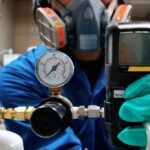Introduction: tackling air pollution from transport
Air pollution from transport is a pressing issue that impacts the health and well-being of millions of people globally. Despite the increasing adoption of public transport systems, roads remain congested with cars and trucks, contributing significantly to urban air pollution. Balancing the daily mobility of people and goods with the urgent need for sustainability is a challenge we can no longer afford to ignore.
This article delves into the causes and effects of air pollution from transport and explores practical solutions to mitigate its impact. We’ll also examine the critical role of air qualityAir quality refers to the state of the air we breathe and its composition in terms of pollutants present in the atmosphere. It is considered good when poll...
Read more monitoring in managing urban pollution and highlight how innovative solutions like those offered by Kunak are paving the way for a future where sustainable mobility and public health coexist seamlessly.
From the combustion of fossil fuels like petrol and diesel to particulate matter generated by tyre and brake wear, the sources of pollution are diverse and complex. Understanding and measuring these emissions is essential for ensuring cleaner cities, healthier populations, and a more sustainable future.
What is air pollution from transport?
Air pollution from transport refers to the release of harmful pollutants into the atmosphere as a result of the operation of vehicles and transport systems. These pollutants originate primarily from the burning of fossil fuels such as petrol and diesel, used to power cars, trucks, ships, trains, and airplanes. Additionally, non-combustion sources, such as tyre and brake wear, also contribute to air pollution, especially in urban areas with high traffic density.
This form of pollution not only degrades air quality but also poses significant risks to public health and the environment. It is a major contributor to greenhouse gas emissions, exacerbating climate change, and has been linked to respiratory and cardiovascular illnesses in humans. Understanding its sources and dynamics is essential to developing strategies for cleaner, more sustainable transport systems.
Air Quality Innovation in Just 1 Click
Stay informed about the air you breathe!
Subscribe to our newsletter to receive the latest updates on environmental monitoring technology, air quality studies, and more.
Main sources of transportation-related pollution
Transport-related air pollution stems from a variety of sources, each contributing uniquely to the overall problem. From private vehicles to global shipping and aviation, each mode of transport has its own set of emissions challenges.
Below, we explore the main contributors:
Cars and light-duty vehicles
Private cars and small passenger vehicles represent one of the largest sources of transport-related air pollution. They emit a variety of harmful substances, including carbon dioxide (CO₂), nitrogen oxides (NOₓ), and particulate matter (PM)Atmospheric particulate matter are microscopic elements suspended in the air, consisting of solid and liquid substances. They have a wide range of sizes an...
Read more. The widespread use of petrol and diesel vehicles in urban and suburban areas makes them a key focus for emission reduction initiatives. Transitioning to electric vehicles and encouraging shared mobility are vital steps to mitigate their impact.
Trucks and heavy-duty vehicles
Heavy-duty vehicles, such as lorries and freight trucks, are essential for goods transportation but are also major polluters. These vehicles consume significant amounts of diesel fuel, releasing high levels of NOₓ and PM into the atmosphere. Their emissions are particularly concerning in logistics hubs and along major transport corridors, where air quality often suffers as a result.
Maritime transport
Shipping is a critical component of global trade, yet it is a significant source of air pollution, especially in port cities. Large ships run on heavy fuel oil, which produces high emissions of sulfur oxides (SOₓ), NOₓ, and fine particulate matter. With growing concerns about the environmental impact of shipping, the International Maritime Organization (IMO) has introduced regulations to limit sulfur emissions, and new technologies like LNG-powered ships are gaining traction. You can see what the environmental impact of shipping is in https://kunakair.com/air-quality-ports/ that we recently updated.
Aviation
The aviation sector contributes to air pollution through the combustion of jet fuel, releasing CO₂, NOₓ, and water vapour into the atmosphere. Airports also contribute to local pollution through ground operations, including the use of support vehicles and auxiliary power units. While the sector represents a smaller share of global transport emissions, its environmental impact is amplified by high-altitude emissions, which have a greater warming effect. Check out the article where we analyzed this source of pollution and its effects here.
Public transportation
Although public transport systems, such as buses, trams, and trains, are generally more environmentally friendly per passenger compared to private vehicles, they still contribute to air pollution when powered by fossil fuels. Diesel-powered buses, in particular, can be significant sources of NOₓ and PM. Transitioning to electric or hydrogen-powered fleets and improving the efficiency of public transport networks are essential for reducing their environmental footprint.
Key pollutants emitted by transport
Transport systems release a variety of pollutants that negatively impact air quality, human health, and the environment. These pollutants come from combustion engines, fuel processing, and non-exhaust sources like tyre and brake wear. Below are the primary pollutants associated with transportation and their impacts.
Carbon dioxide (CO₂)
CO₂ is the most significant greenhouse gas emitted by vehicles. It is a byproduct of burning fossil fuels, such as petrol, diesel, and natural gas, for energy. While not directly harmful to human health at low concentrations, CO₂ is the leading contributor to global warming and climate change. Reducing CO₂ emissions requires transitioning to renewable energy sources, increasing vehicle efficiency, and promoting electric and hybrid vehicles.
Nitrogen oxides (NOₓ)
NOₓ refers to a group of reactive gases, including nitrogen dioxide (NO₂) and nitric oxide (NO), that are primarily released from vehicle exhaust. These gases contribute to the formation of ground-level ozone and fine particulate matter, both of which are harmful to human health. NOₓ exposure can lead to respiratory issues, aggravate asthma, and decrease lung function. Heavy-duty vehicles, diesel engines, and older petrol engines are significant sources of NOₓ emissions.
Particulate matter (PM10 and PM2.5)
Particulate matter, or PM, consists of tiny particles suspended in the air, classified by their size: PM10 (particles smaller than 10 microns) and PM2.5 (particles smaller than 2.5 microns). These particles are emitted from combustion engines and also arise from tyre and brake wear. PM2.5, in particular, can penetrate deep into the lungs and bloodstream, leading to serious health problems such as heart disease, lung cancer, and respiratory infections.
Volatile Organic Compounds (VOCs)
VOCs are a group of organic chemicals that evaporate easily into the air. They are emitted from fuel combustion, vehicle refuelling, and the use of certain vehicle materials. VOCs contribute to the formation of ground-level ozone and smogSmog, beyond that dense fog
Smog is a mixture of air pollutantsAir pollution caused by atmospheric contaminants is one of the most critical and complex environmental problems we face today, both because of its global r...
Read more that accumulate in the atmosphere, especially in urban areas. This phenomenon is character...
Read more, both of which harm air quality and human health. Common VOCs from transport include benzene and toluene, which are linked to long-term health risks such as cancer and neurological damage.
Sulfur dioxide (SO₂)
SO₂ is primarily emitted by vehicles running on sulfur-containing fuels, such as heavy fuel oil in ships and low-grade diesel. It contributes to acid rain formation and can irritate the respiratory system. While regulations on fuel sulfur content have significantly reduced SO₂ emissions in many regions, it remains a concern in areas with high shipping activity and less stringent fuel standards.
The effects of transportation-related air pollution
Air pollution from transport has far-reaching consequences, affecting both human health and the environment. The continuous release of harmful pollutants creates a chain reaction of adverse effects that ripple through society and ecosystems. Below, we explore the primary impacts of transportation-related air pollution.
Impacts on human health
The pollutants released by transport systems are among the leading causes of health problems worldwide. Prolonged exposure to air pollution significantly increases the risk of serious illnesses and premature death.
Respiratory diseases
Pollutants like PM2.5, NOₓ, and VOCs irritate the respiratory system, causing or exacerbating conditions such as asthma, chronic bronchitis, and lung infections. Vulnerable populations, including children and the elderly, are particularly at risk.
Cardiovascular problems
Fine particulate matter (PM2.5) has been linked to cardiovascular diseases, including heart attacks and strokes. These particles enter the bloodstream and contribute to inflammation and arterial damage, increasing the risk of heart-related complications.
Premature mortality
Studies estimate that millions of premature deaths occur annually due to air pollution. Transportation emissions are a major contributor, with their impact most pronounced in urban areas with high traffic density. Reducing emissions is critical to improving life expectancy and overall public health.
Environmental impacts
Beyond human health, transportation-related air pollution significantly affects the environment, leading to widespread ecological damage and contributing to global environmental crises.
Climate change
Carbon dioxide (CO₂) emissions from vehicles are a primary driver of global warming. Additionally, other pollutants like black carbon, a component of PM2.5, have a warming effect on the atmosphere. These emissions disrupt natural weather patterns, melt polar ice caps, and increase the frequency of extreme weather events.
Acid rain
Sulfur dioxide (SO₂) and nitrogen oxides (NOₓ) react with water vapour in the atmosphere to form acidic compounds, which fall to the ground as acid rain. This phenomenon damages soil, vegetation, and water bodies, disrupting ecosystems and harming agriculture.
Impact on biodiversity
Pollutants from transport can accumulate in ecosystems, harming flora and fauna. Ground-level ozone and nitrogen deposition degrade habitats, reduce crop yields, and threaten the survival of species. In marine environments, emissions from shipping contribute to ocean acidification, which endangers marine biodiversity.
Technologies for measuring air pollution from transport
Accurately measuring air pollution from transport is essential for developing effective strategies to mitigate its impact. Advances in monitoring technologies have enabled better detection and more comprehensive understanding of transport-related emissions. Below, we explore both traditional and emerging methods of air quality monitoringControlling air quality is an essential task in order to enjoy optimal environmental conditions for healthy human development and to keep the environment i...
Read more, as well as the contributions of Kunak in the field.
Traditional methods of air quality monitoring
Historically, air quality monitoring relied on fixed, large-scale methods that provided data on pollution levels in a specific area. While these systems are still in use, they often have limitations in terms of coverage and real-time data.
Stationary monitoring stations
Stationary monitoring stations are fixed installations designed to measure air quality over a specific location. These stations typically include sensors that detect a variety of pollutants, including CO₂, NOₓ, PM2.5, and ozone. While stationary stations provide valuable long-term data, their coverage is limited to the specific location they are installed in, often missing data from other high-traffic areas or mobile sources.
Satellite imagery and remote sensing
Satellite imagery and remote sensing technologies offer a broader view of air pollution by measuring pollutants from space. These technologies can provide valuable insights into large-scale trends and pollution hotspots. However, they tend to have less accuracy in capturing the real-time, ground-level concentration of pollutants, which makes them complementary to more localized monitoring methods.
Emerging technologies for accurate monitoring
With the rise of more advanced and compact technologies, air quality monitoring has become more precise, real-time, and mobile. Emerging solutions are making it easier to track air pollution on a more granular level, even in urban areas with high traffic density.
Sensor-based air quality monitoring systems
Sensor-based monitoring systems, such as the Kunak AIR Pro and Kunak AIR Lite, provide a more flexible and cost-effective way to monitor air quality. These systems use various sensors to detect pollutants like CO₂, NOₓ, particulate matter, and VOCs in real time. Their small size and ease of installation allow them to be placed in a variety of locations, from roadsides to building rooftops, offering detailed, high-resolution data that is often not available with traditional monitoring methods.
Mobile and portable monitoring solutions
Mobile and portable air quality monitoring solutions have revolutionised how data is collected in real-time. These systems, often mounted on vehicles or drones, can track air pollution across large areas and provide highly detailed data. By enabling mobile monitoring, they allow for the detection of pollution hotspots, particularly along transport corridors or in areas where fixed stations may not be present. These solutions are especially useful in gathering data from diverse transport modes, such as buses, trucks, and trains.
Kunak’s contribution to air pollution measurement
Kunak has been at the forefront of the development of innovative, precise, and cost-effective air quality monitoring solutions. Kunak’s sensors and systems offer real-time data collection with the flexibility to be integrated into a variety of applications, particularly within smart cities and transportation networks.
Overview of Kunak AIR Pro and Kunak AIR Lite
Kunak AIR Pro and Kunak AIR Lite are advanced air quality monitoring stations designed to measure a wide range of pollutants emitted by transport. These systems are equipped with state-of-the-art sensors capable of detecting pollutants like CO₂, NOₓ, PM2.5, and VOCs. Compact, reliable, and easy to deploy, these systems provide high-accuracy data essential for urban and transport planning.
Real-time monitoring capabilities
Kunak’s monitoring systems offer real-time data, allowing for immediate insights into air quality levels. This enables rapid decision-making, which is critical for managing air pollution in urban environments, particularly in response to sudden spikes in transport emissions. Real-time monitoring also supports timely intervention, helping municipalities and organisations to take corrective action quickly.
Integration with smart cities and transportation networks
Kunak’s air quality monitoring systems are designed to integrate seamlessly into smart city frameworks and transportation networks. By connecting air quality data to city-wide management platforms, local authorities and urban planners can gain a better understanding of how transport-related emissions affect air quality across different zones. This data-driven approach allows for the implementation of more effective, targeted solutions to improve urban air quality.
Case studies: Successful applications in urban environments and ports
Kunak’s solutions have been successfully implemented in various urban environments and ports to monitor transport-related air pollution. In one case, Kunak AIR Pro units were deployed at key intersections and transport hubs in a major city, providing real-time insights into traffic-related emissions. Similarly, Kunak’s solutions have been used at ports to monitor emissions from ships and trucks, supporting efforts to reduce pollution and comply with environmental regulations. These case studies highlight the effectiveness of Kunak’s air quality monitoring systems in reducing transport-related pollution in real-world scenarios.
Solutions to reduce transportation pollution
Reducing pollution from transport requires a multifaceted approach that includes technological advancements, infrastructure improvements, policy measures, and behavioural changes. Implementing sustainable practices in transportation not only improves air quality but also contributes to climate change mitigation and public health. Below are several solutions that can help significantly reduce transportation-related pollution.
Transition to low-emission and electric vehicles (evs)
One of the most effective solutions to reduce emissions from transport is the widespread adoption of low-emission and electric vehicles (EVs). By replacing conventional internal combustion engine vehicles with electric and hybrid alternatives, the transport sector can drastically cut its carbon footprintIn a world increasingly affected by climate change, understanding how our everyday actions contribute to its worsening has become essential. The carbon foo...
Read more and reduce harmful pollutants.
- Electric Vehicles (EVs): EVs produce zero tailpipe emissions, which means they don’t contribute to CO₂, NOₓ, or particulate matter when operating. With continued advancements in battery technology and an expanding network of charging stations, EVs are becoming increasingly accessible and affordable. Governments worldwide are implementing policies and incentives to promote EV adoption, helping to create a cleaner, more sustainable transportation sector.
- Hybrid Vehicles: Hybrid vehicles, which combine an internal combustion engine with an electric motor, offer a middle ground between traditional vehicles and fully electric ones. They can reduce fuel consumption and emissions while offering more flexibility for drivers in regions where charging infrastructure is still limited.
Promoting public and active transport
Encouraging the use of public transportation and active mobility options, such as cycling and walking, can significantly reduce the number of private vehicles on the road, thereby lowering transport-related pollution.
Public transportation
Public transportation systems, such as buses, trains, and trams, have a much lower per capita emission rate compared to private cars. By offering efficient and affordable public transport, cities can reduce congestion, lower CO₂ emissions, and improve air quality. Investing in modern, electric, or hybrid public transport fleets can further reduce pollution from these systems.
Cycling and walking infrastructure
Providing safe and convenient infrastructure for cycling and walking encourages individuals to choose these environmentally friendly modes of transport. Not only does this reduce traffic congestion and pollution, but it also promotes physical health and well-being. Cities can invest in dedicated cycling lanes, pedestrian zones, and other infrastructure improvements to make cycling and walking more attractive and accessible.
Adopting cleaner fuels and technologies
Transitioning to cleaner fuels and technologies is crucial for reducing the emissions from traditional transport systems. By shifting to alternative fuels and incorporating new technologies, we can significantly cut the impact of transport on air quality and the environment.
- Biofuels and Hydrogen: Biofuels, such as ethanol and biodiesel, are produced from renewable resources and can replace conventional petrol and diesel in internal combustion engines. These fuels produce fewer greenhouse gasesWhile the concentration of carbon dioxide (CO2) in the atmosphere has been steadily and rapidly increasing in recent decades, in May 2025, CO2 surpassed 43...
Read more and pollutants when burned. Hydrogen fuel, which can power fuel cell vehicles, is another promising clean alternative. When produced from renewable sources, hydrogen offers the potential for a zero-emission transport solution, although infrastructure challenges remain. - Renewable Energy-Powered Transport Systems: The integration of renewable energy sources, such as solar, wind, and hydropower, into transportation systems can reduce reliance on fossil fuels. Electrifying public transport systems and charging EVs with renewable energy further cuts the overall environmental impact. The use of solar-powered electric vehicles and the development of green transport technologies offer exciting possibilities for the future.
Urban planning and traffic management
Well-designed urban planning and traffic management systems are vital for reducing transportation-related pollution. By optimizing infrastructure and reducing congestion, cities can mitigate the environmental impact of transport.
Low Emission Zones (LEZs)
LEZs are areas within cities where only vehicles that meet strict emissions standards are allowed to enter. By limiting access to high-emission vehicles, these zones help reduce air pollution in densely populated areas. Many cities have successfully implemented LEZs to improve air quality and encourage the use of cleaner transport options, such as EVs and public transit.
Intelligent traffic systems
Intelligent traffic management systems use real-time data to optimize traffic flow, reduce congestion, and minimise fuel consumption. These systems can adjust traffic lights, provide route recommendations, and manage traffic in a way that reduces the overall environmental impact of transport. In addition, such systems can support the integration of electric vehicle charging infrastructure, making it easier for drivers to use EVs.
Policies and regulations
Strong policies and regulations are essential for driving change and encouraging the transition to cleaner, more sustainable transportation systems. Governments play a crucial role in setting the framework for reducing transportation-related pollution.
- Government Initiatives: Many governments around the world have introduced policies to reduce emissions from transport, such as offering incentives for EV purchases, investing in public transport infrastructure, and implementing stricter emissions standards for vehicles. These initiatives encourage the adoption of cleaner transport options and provide financial support for green technologies.
- International Agreements: International agreements, such as the Paris Agreement, set global targets for reducing greenhouse gas emissions, including those from the transport sector. Through cooperation and joint efforts, countries can work together to address transport-related pollution on a global scale. International agreements also foster the sharing of knowledge and best practices, helping to accelerate the transition to a cleaner, more sustainable transport system.
The role of public awareness in tackling transportation pollution
Public awareness is crucial in the fight against transportation-related pollution. Without an informed and engaged public, policies and technological solutions may struggle to make a meaningful impact. By educating citizens about the health and environmental risks of air pollution from transport, we can encourage behaviour change that contributes to cleaner air and a more sustainable future.
Educational campaigns
Educational campaigns play a vital role in raising awareness about the dangers of transportation-related pollution. Governments, non-governmental organisations, and other stakeholders can launch campaigns to inform the public about the sources and effects of transport pollution and the steps individuals can take to reduce their environmental footprint. These campaigns can include:
- Public Service Announcements (PSAs): PSAs through television, radio, social media, and digital platforms can help spread the message to a wide audience, highlighting the impact of transport-related pollution and promoting sustainable alternatives.
- Workshops and Community Engagement: Local workshops and community outreach programmes can offer individuals practical information on how they can contribute to cleaner air, such as using public transport, cycling, or adopting electric vehicles.
Citizen Participation and Behavior Change
Citizen participation is an essential component in reducing transportation pollution. Engaging individuals and communities in the decision-making process can lead to more sustainable behaviours and practices.
- Incentivising Sustainable Practices: By offering incentives, such as tax breaks for EVs or rewards for using public transportation, citizens can be encouraged to choose greener transport options.
- Carpooling and Shared Mobility: Encouraging carpooling and the use of shared mobility services, such as ride-sharing and bike-sharing schemes, can help reduce the number of vehicles on the road and decrease pollution levels.
Behaviour change is also about shifting public perceptions. The more people understand the environmental and health impacts of their daily choices, the more likely they are to adopt sustainable transport habits.
Success stories from cities leading the way
Many cities around the world have already implemented successful measures to combat transportation pollution. These success stories serve as important examples of what can be achieved when governments, businesses, and citizens work together.
- Copenhagen (Denmark): Known as one of the world’s greenest cities, Copenhagen has invested heavily in cycling infrastructure and aims to become carbon-neutral by 2025. The city’s efforts to promote cycling as a primary mode of transportation have significantly reduced transport-related emissions.
- London (United Kingdom): The introduction of the Ultra Low Emission Zone (ULEZ) in London has helped to reduce pollution from vehicles in the city centre. By charging older, more polluting vehicles to enter the area, the city has seen a decrease in nitrogen dioxide (NO₂) levels and a cleaner urban environment.
- Bogotá (Colombia): Bogotá’s TransMilenio bus rapid transit system has been a huge success in reducing air pollution. The city has also implemented car-free days, encouraging citizens to opt for cleaner modes of transport.
These cities have proven that with the right policies, infrastructure, and public engagement, it is possible to reduce transportation-related pollution and improve urban air quality.
Sustainable transport for cleaner air
Sustainable transport solutions play a key role in improving urban air quality. Transitioning from traditional, high-emission vehicles to cleaner, low-emission alternatives is essential for combating pollution from transport.
Innovations in green transportation
Green transportation innovations are transforming the way we think about mobility. These technologies have the potential to revolutionise the transport sector, making it cleaner, more efficient, and sustainable.
- Autonomous Vehicles: Autonomous vehicles (AVs) have the potential to reduce transport-related pollution by optimising traffic flow, reducing congestion, and ensuring more efficient driving. By removing human errors such as aggressive acceleration or braking, AVs can improve fuel efficiency and reduce emissions. Additionally, many AVs are designed to be electric, further reducing pollution from transportation.
- Hyperloop and Other Futuristic Solutions: The Hyperloop, a high-speed transport system using magnetic levitation technology, promises to revolutionise long-distance travel. With the potential to operate using renewable energy and significantly reduce travel times, the Hyperloop could reduce the need for air travel and long-distance road transport, leading to lower emissions.
Other futuristic solutions, such as flying cars or electric vertical take-off and landing (eVTOL) aircraft, are also being developed. While still in early stages, these innovations could significantly contribute to reducing pollution by offering alternative modes of transportation that are cleaner and more efficient.
Collaborative efforts for a sustainable future
Addressing transportation-related pollution requires the collective effort of governments, businesses, and individuals. Each plays a unique and important role in building a sustainable transport future.
Role of governments, businesses, and individuals
- Governments: Governments play a crucial role in creating and enforcing policies to reduce transport-related pollution. By implementing regulations such as emission standards, investing in green transport infrastructure, and promoting incentives for cleaner vehicles, governments can guide the transition to a more sustainable transport system.
- Businesses: Businesses, particularly those in the automotive, logistics, and energy sectors, have a significant role to play in reducing transportation pollution. By adopting clean technologies, such as electric vehicles and renewable energy-powered transport fleets, and encouraging sustainable practices within their operations, businesses can help reduce emissions.
- Individuals: Individuals can contribute by making conscious decisions about their transportation choices. Opting for public transport, carpooling, cycling, walking, and choosing electric vehicles are all ways to reduce one’s personal carbon footprint. When individuals make sustainable choices, they not only reduce pollution but also encourage others to do the same.
The collaboration between these three key sectors is essential for creating a cleaner, healthier, and more sustainable transport system that benefits both the environment and public health.
Real examples in which Kunak’s technology helps reduce pollution from transport
Kunak offers monitoring solutions based on the most innovative technologies, providing excellent data quality that complements the readings collected by reference systems and expands the information available, that “snapshot” of what the air quality is like in a given environment.
However, decision-making is up to you.
And making decisions based on reliable data is exactly what they are doing in places as far away as:
- Cartagena de Indias, in Colombia, a city in which the sensor network will allow real-time monitoring of air quality and detect critical points and potential causes of urban pollution.
- Valparaíso, in Chile, where Kunak has implemented a solution in the metro network that continuously monitors gases and particles.
- Albacete, where an air quality monitoringControlling air quality is an essential task in order to enjoy optimal environmental conditions for healthy human development and to keep the environment i…Read more network has been installed that measures atmospheric conditions (including vehicle traffic) in real-time.
- Rivas-Vaciamadrid, which also has a network of sensor-based stations to complement other measurements in an area that, like the outskirts of Madrid, has a high traffic density.
Urban transport pollution monitoring is the first step in reducing emissions and ensuring the quality of life and health of people, especially in urban environments. With advanced technology and appropriate actions, it is possible to improve air quality and offer a higher level of well-being to inhabitants and visitors.
Even more so if that technology bears the signature of Kunak.
Frequently Asked Questions (FAQs)
What are the main causes of air pollution from transport?
Air pollution from transport is primarily caused by emissions from vehicles burning fossil fuels. Major contributors include cars, trucks, ships, airplanes, and public transport vehicles using diesel or gasoline.
How does air pollution from transport affect human health?
Exposure to pollutants like nitrogen oxides (NOₓ), particulate matter (PM), and carbon monoxide (CO)The carbon monoxide (CO) is an invisible gas (colorless and odorless) that, at the same time, is a silent killer because in just a few minutes it exhibits ...
Read more can lead to respiratory issues, cardiovascular diseases, and other chronic health conditions.
Which are the most common pollutants from vehicles?
The most common pollutants include CO₂, NOₓ, PM10, PM2.5, sulfur dioxide (SO₂), and volatile organic compounds (VOCs).
How can air pollution from transportation be reduced?
Solutions include transitioning to electric vehicles, using public transportation, adopting cleaner fuels, improving traffic management, and implementing stricter emissions regulations.
What technologies are used to monitor air pollution from transport?
Air quality is monitored using traditional stationary stations, mobile sensors, satellite data, and advanced systems like Kunak AIR Pro and Kunak AIR Lite for real-time, precise measurements.
What are Low Emission Zones (LEZs), and how do they help?
LEZs are areas where the most polluting vehicles are restricted or charged to reduce emissions. They encourage cleaner transportation and improve urban air quality.
Conclusion: a call to action for cleaner air
In conclusion, air pollution from transportation remains one of the most pressing environmental challenges facing urban areas today. As cities continue to grow and mobility demands increase, the need for effective solutions to reduce transportation-related pollution is more urgent than ever. The consequences of air pollution are far-reaching, impacting not only the health of individuals but also the environment, economy, and overall quality of life in urban areas.
Accurate and real-time air quality monitoring is a crucial tool in addressing this issue. Technologies such as Kunak’s air quality monitoring systems provide the precise data necessary to understand pollution levels and track their fluctuations throughout the day. By offering detailed insights into the sources and intensity of air pollution, these systems enable local authorities to make informed decisions and take targeted actions to reduce emissions from transportation.
Moreover, sharing this information transparently with the public is essential. When citizens are informed about the air quality in their communities, they can take proactive steps in their daily routines—whether by choosing cleaner transport options or supporting local policies that promote sustainability. Public awareness, combined with the right technological tools and policies, can drive positive change and foster a collective effort to protect the environment and public health.
Governments, businesses, and individuals must work together to make cleaner, sustainable mobility a reality. From transitioning to low-emission and electric vehicles to investing in cleaner fuels and smarter traffic management systems, every action counts. Ultimately, through collaboration and the responsible sharing of information, we can create cities where air quality improves, public health thrives, and future generations can enjoy the benefits of a sustainable, cleaner environment.
By embracing the power of precise air pollution measurement and committing to transparency, we take an important step toward safeguarding the health of citizens and ensuring a greener, more sustainable future for all.









